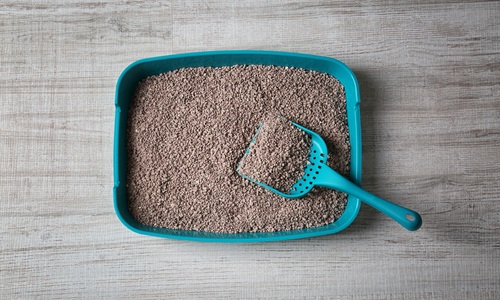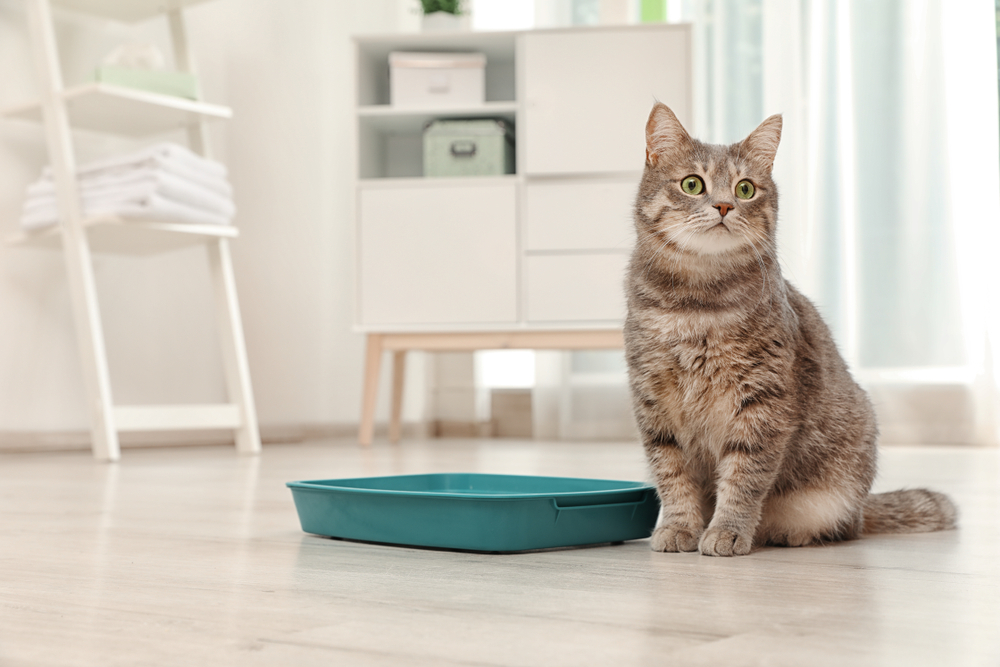There are few things more off-putting than walking into someone’s home and being hit with that unmistakable odor: cat urine. The pungent ammonia-like smell is hard to miss – and no matter how clean a house or apartment may appear, the aroma of kitty urine can be not only offensive, but trigger major allergy attacks in certain people.
Due to its biological composition, cat pee is not only overpowering, but long-lasting – if it isn’t cleaned up quickly, it can last in porous surfaces for years. For many owners, the struggle is real: the odor of cat urine often poses an ongoing challenge, particularly for homes with multiple cats. In fact, many folks find themselves facing a losing battle when attempting to keep foul feline odors at bay. So, what’s a cat parent to do? Read on to learn helpful tips, including how to get rid of cat urine smell – along with the science behind this smelly problem!
The Science Behind The Smell: Why Cat Urine Odor Is So Hard To Get Rid Of
For pet parents constantly fighting off the stink of cat urine in their homes, it’s helpful to understand the science behind the offending odor. Cat urine is made up of uric acid, a waste byproduct that is formed when mammals (including humans and felines) break down food during digestion. In turn, the uric acid is eliminated from the body via urine and fecal matter. However, unlike their human counterparts, cats don’t drink large quantities of water, so their urine is much more concentrated. As a result of the high levels of uric acid and proteins that are also present in cat urine, it results in a strong (and very distinctive) odor that is extremely difficult to eradicate from carpets, floors, upholstery, and other surfaces in the home.

Furthermore, it is also worth noting the pH levels of cat urine, as the biological composition is in direct correlation with its powerful stench. When a cat goes to the litter box, his urine is acidic. However, as the urine dries, the uric acid formulates into urine salts (also known as ‘crystals’) and becomes alkaline. While a cat requires a certain acidity level to maintain a healthy urinary tract, his owners may find it difficult to remove the cat urine smell from their household.
Getting Rid Of Stubborn Cat Urine Odors: A Step-By-Step Guide
Once pet parents have a better understanding of cat urine from a biological standpoint, the next step is figuring out how to get rid of the cat urine smell in the house or apartment unit. This involves some detective work – including identifying where the odors are actually coming from – in order to eliminate them at the source. In order to determine this information, owners will have to pinpoint where the cats may be urinating (outside of their litter boxes). Below, a step-by-step guide to finding cat urine stains throughout the home:
Locate The Source
While most pet parents know their fur babies tend to urinate in tucked-away places (think up against the wall, in the corner of the basement, or any place that has a clearly-defined border), finding precisely where the family cat peed can be tricky at times. However, it’s essential to locate these often invisible spots in order to de-funk them. Many expert cleaning companies recommend using a blacklight to locate the source of the offending urine-stained areas – for suggestions, check out this article when shopping online for the best blacklight for cat urine. Utilizing ultra-violet rays, the urine stains will emit a glow when the black light is used in a darkened room. A word to the wise: before turning out the lights, be sure to keep a roll of masking tape on hand – this is a handy way to ‘mark’ the areas where there appears to be cat pee. On the contrary, although blacklights are helpful, they’re not 100% reliable. Therefore, stains may have to be discovered the old-fashioned way – the sniff test.
Stink Removal STAT

After the soiled areas have been established, it’s time to tackle those stinky spots. While there are plenty of ways to get rid of smelly cat pee stains, it’s crucial to tend to them as soon as possible – the longer they marinate, the harder it will be to banish the odor. For wet stains, be sure to blot up urine quickly with an old rag or towel. Next, use a wet/dry vacuum to remove additional fluids beneath the surface of the carpet or upholstered area. For dry stains, treat them full-strength as soon as they’re discovered – there are numerous types of products on the market designed specifically for odor and pet urine removal. Be sure to test first in an inconspicuous area to avoid bleaching or staining the rugs/upholstery, and read labels carefully for toxic or harmful ingredients. Although there are natural treatment methods and commercial products that feature enzymes and other chemicals to neutralize odors, it’s worth experimenting with both options to see which yields the best results. For additional info, check out this article to discover the best cat pee and stain removal products of 2020.
Pro Tip: In order to prevent ‘repeat performances’ from frisky felines, be sure to clean up accidents ASAP – if odors aren’t eradicated thoroughly, lingering aromas may entice him to pee in the same spot. It’s also essential for pet parents to check for kitty health issues: bring him to the vet if he’s peeing frequently outside of the litter box. He may be suffering from any number of health problems, including a UTI, feline diabetic complications, kidney issues, or other medical conditions that may be at the root cause of these incidents. Finally, ask the veterinarian about his diet: a cat’s nutrition and his urinary health go hand in hand. While at the clinic, owners may wish to speak to their vet about the benefits of natural supplements for cats to support his overall health.
Remove Carpeting Whenever Possible
Another angle to consider: remove wall-to-wall carpeting whenever possible. For renters, this may be more difficult, but for homeowners (or apartment dwellers whose landlords don’t mind some minor renovations), ripping up old carpeting is one of the most effective methods of reducing cat urine odor. Since cat urine lingers in porous areas – including furniture, walls, and even wood – minimizing upholstered surfaces can help reduce the incidence of stubborn urine stains and make wet clean-up and overall maintenance more manageable. Carpeting can be particularly troublesome, since there’s not only one layer of carpet, but the backing, padding, and sub-floor beneath it that gets soaked during a staining incident. Therefore, hardwood or laminate floors, linoleum, ceramic, or even peel-and-stick tiles offer a much easier-to-maintain option. For areas where a little carpeting is a must, consider small-sized area rugs, which can be cleaned with a lot less effort.
Keep It Clean (Kitty Litter, That Is)

For anyone who owns a cat, it’s a known fact that they’re finicky by nature. So while it may seem like common sense that keeping a clean and tidy litter box is fundamental to keeping one’s home as fresh-smelling and odor-free as possible, it’s not for one but actually two reasons. First, emptying it on a regular basis of course eliminates the dirty litter, but secondly (and perhaps even more important in the fight against urine stains and odors indoors) – cats don’t like using a soiled litter box! In fact, once a cat stops eliminating in his litter box on a regular basis, it may quickly become an ongoing problem – e.g., your dining room carpet becomes his new spot for doing his business. Nip this behavior in the bud by paying attention to his cues and bathroom habits, and make an appointment with the vet if it calls for it. For starters, be sure to keep the litter box clean, use baking soda in-between to freshen it up, and find a high-quality cat litter that’s effective at fighting odor. There are numerous reasons why your cat may have developed an elimination problem, as outlined in this piece by the ASPCA. This article is filled with valuable info for pet parents seeking answers on common cat behavior, and how to address their troublesome litter box habits.
Call A Pro Cleaner
Finally, for seemingly impossible stains that just won’t budge, it may be time to call in the big guns and hire a professional cleaning service. Pet parents may wish to do a quick search online to find local carpet-cleaning services in their area. Once a rep is contacted, they will usually visit for a consultation and advise a cleaning regimen, which may include different pet odor elimination services and urine removal suggestions. Based on the customer’s preference – including ‘green’ or eco-friendly options – a reputable carpet cleaning company should be able to assist with stubborn pet odors, including the smell of cat urine.
As mentioned earlier, if an owner suspects that the cat is suffering from an underlying medical issue, it’s important to contact a vet right away. In turn, the clinic will be able to determine if the cat is experiencing any health problems, which may be the cause behind the frequent accidents. If the accidents are intentional and perhaps due to environmental stress, you may want to consider CBD for cats to relieve some anxiety. In addition, a trusted vet can provide valuable insight, including behavioral and/or medical issues which may be impacting your cat’s elimination routine.
Sources Cited:
- “How to Remove Cat Urine From Your Carpet.” The Maids (themaidsofri.com), (no published date), https://www.themaidsofri.com/blog/how-to-remove-cat-urine-from-your-carpet-1. Accessed October 21, 2020.
- Klinger, Chrissie. “Removing Foul Smelling Cat Odors From Your Home.” Hill’s (hillspet.com), October 21, 2016, https://www.hillspet.com/cat-care/resources/getting-rid-of-cat-odors#:~:text=Cleaning%20the%20area%20thoroughly%20with,hardwood%20floors%2C%20carpets%2C%20mattresses. Accessed October 21, 2020.
- Garrity, Amanda. “How to Get Rid of That Cat Pee Smell on Carpets, Wood, and Upholstery.” Good Housekeeping (goodhousekeeping.com), December 17, 2018, https://www.goodhousekeeping.com/home/cleaning/a25351223/cat-pee-smell/. Accessed October 21, 2020.
- “Litter Box Problems.” ASPCA (aspca.org), (no published date), https://www.aspca.org/pet-care/cat-care/common-cat-behavior-issues/litter-box-problems. Accessed October 21, 2020.




